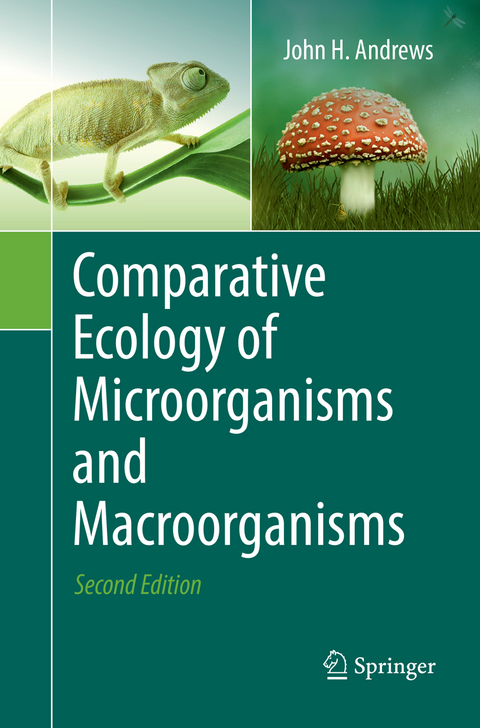
Comparative Ecology of Microorganisms and Macroorganisms
Springer-Verlag New York Inc.
978-1-4939-8331-5 (ISBN)
This second edition textbook offers an expanded conceptual synthesis of microbial ecology with plant and animal ecology. Drawing on examples from the biology of microorganisms and macroorganisms, this textbook provides a much-needed interdisciplinary approach to ecology. The focus is the individual organism and comparisons are made along six axes: genetic variation, nutritional mode, size, growth, life cycle, and influence of the environment. When it was published in 1991, the first edition of Comparative Ecology of Microorganisms and Macroorganisms was unique in its attempt to clearly compare fundamental ecology across the gamut of size. The explosion of molecular biology and the application of its techniques to microbiology and organismal biology have particularly demonstrated the need for interdisciplinary understanding. This updated and expanded edition remains unique. It treats the same topics at greater depth and includes an exhaustive compilation of boththe most recent relevant literature in microbial ecology and plant/animal ecology, as well as the early research papers that shaped the concepts and theories discussed. Among the completely updated topics in the book are phylogenetic systematics, search algorithms and optimal foraging theory, comparative metabolism, the origins of life and evolution of multicellularity, and the evolution of life cycles.
From Reviews of the First Edition:
"John Andrews has succeeded admirably in building a bridge that is accessible to all ecologists." -Ecology
"I recommend this book to all ecologists. It is a thoughtful attempt to integrate ideas from, and develop common themes for, two fields of ecology that should not have become fragmented." -American Scientist
"Such a synthesis is long past due, and it is shameful that ecologists (both big and little) have been so parochial." -The Quarterly Review of Biology
John Andrews was born in Montreal, Canada and did his undergraduate education in agriculture at McGill University. He received graduate degrees from the University of Maine and the University of California, Davis, followed by postdoctoral work at Cambridge University and the University of British Columbia. He was recruited to the faculty at the University of Wisconsin-Madison, where he served for 35 years teaching and doing research in the areas of microbial ecology, plant pathology, and integrated pest management, among several others. He retired in 2010.
1 Introduction: Prospects for a Conceptual Synthesis.- 1.1. Organizing Life.- 1.2. Microorganisms and Macroorganisms: Differences and Similarities.- 1.3 The Centrality of Natural Selection.- 1.4 Analogies, Homologies, and Homoplasies.- 1.5 A Framework for Comparisons.- 1.6 What is an Individual?.- 1.7 Summary.- 1.8 Suggested Additional Reading.- 2 Genetic Variation.- 2.1 Introduction.- 2.2 Mechanisms.- 2.3 Sex and Meiotic Recombination.- 2.4 The Asexual Lifestyle.- 2.5 Somatic Variation, Heritable Variation, and the Concept of the Genet.- 2.6 Summary.- 2.7 Suggested Additional Reading.- 3 Nutritional Mode.- 3.1 Introduction.- 3.2 Carbon and Energy Resources.- 3.3 Resource Acquisition.- 3.4 Nutritional Versatility.- 3.5 Generalists and Specialists.- 3.6 Summary.- 3.7 Suggested Additional Reading.- 4 Size.- 4.1 Introduction.- 4.2 Changes in Size and Development of Life on Earth.- 4.3 On Seeing the World as an Elephant or a Mycoplasma.- 4.4 Some Correlates of Size.- 4.5 Some Ecological Consequences of Size.- 4.6 Size and Life History Theory.- 4.7 Summary.- 4.8 Suggested Additional Reading.- 5 Growth and Growth Form.- 5.1 Introduction.- 5.2 Unitary and Modular Organisms: An Overview.- 5.3 Fungi as Modular Organisms.- 5.4 Bacteria as Modular Organisms.- 5.5 Life Histories of Modular vs. Unitary Organisms.- 5.6 Summary.- 5.7 Suggested Additional Reading.- 6 The Life Cycle.- 6.1 Introduction.- 6.2 Origins and General Considerations.- 6.3 Complex Life Cycles.- 6.4 Senescence.- 6.5 Summary.- 6.6 Suggested Additional Reading.- 7 The Environment.- 7.1 Introduction.- 7.2 The Environment and Organism are Tightly Coupled.- 7.3 How Organisms Experience Environments.- 7.4 Organism Size and Environmental Variation.- 7.5 Genotypic and Phenotypic Variation.- 7.6 The Environment and Life Cycle Changes.- 7.7 Habitable Sites and the Evolution of Dispersal.- 7.8 Summary.- 7.9 Suggested Additional Reading.- 8 Conclusion: Commonalities and Differences in Life Histories.- 8.1 Levels of Comparison.- 8.2 On Being a Macroorganism or a Microorganism.- 8.3 Natural Selection as the Common Denominator.- 8.4 Recapitulation of Some Major Points.- 8.5 On the Comparative Ecology of Microorganisms and Macroorganisms.- 8.6 Summary.- References.- Index.
| Erscheinungsdatum | 24.09.2018 |
|---|---|
| Zusatzinfo | 68 Illustrations, black and white; XVII, 349 p. 68 illus. |
| Verlagsort | New York |
| Sprache | englisch |
| Maße | 155 x 235 mm |
| Themenwelt | Naturwissenschaften ► Biologie ► Evolution |
| Naturwissenschaften ► Biologie ► Mikrobiologie / Immunologie | |
| Naturwissenschaften ► Biologie ► Ökologie / Naturschutz | |
| Naturwissenschaften ► Biologie ► Zoologie | |
| ISBN-10 | 1-4939-8331-8 / 1493983318 |
| ISBN-13 | 978-1-4939-8331-5 / 9781493983315 |
| Zustand | Neuware |
| Haben Sie eine Frage zum Produkt? |
aus dem Bereich


